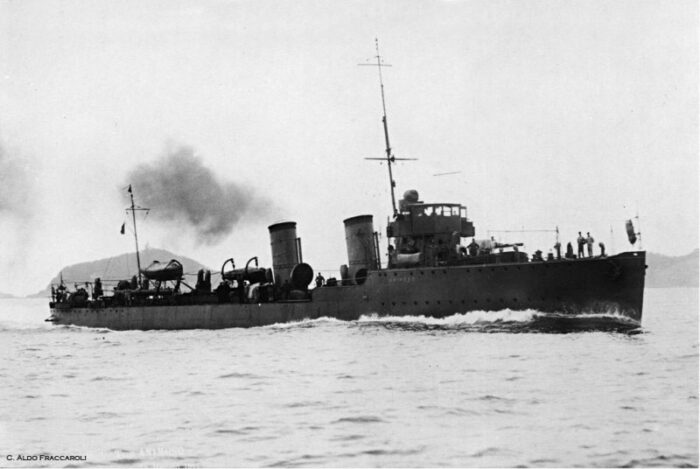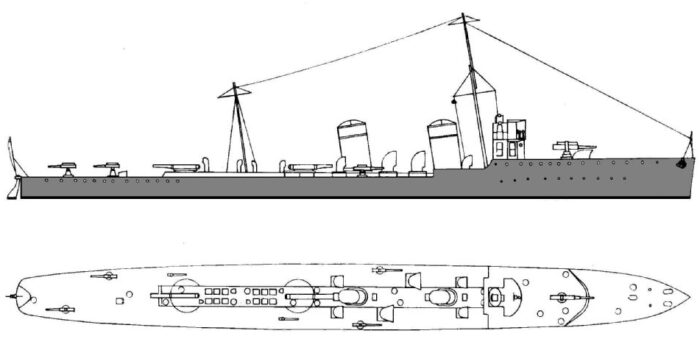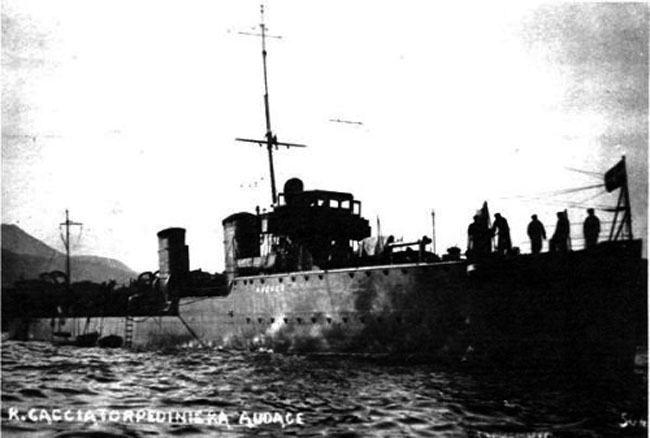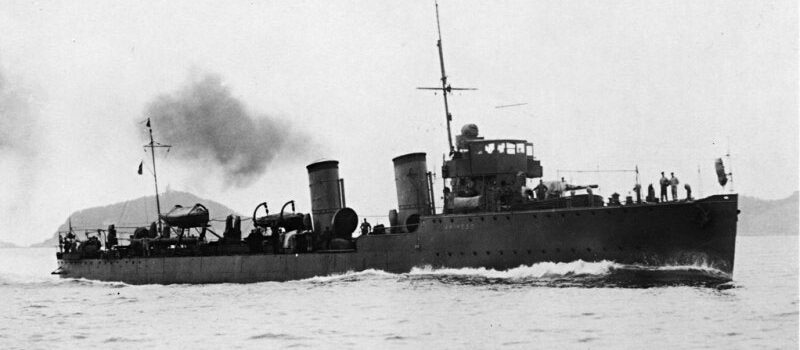 Regia Marina – Audace, Animoso 1913-1916
Regia Marina – Audace, Animoso 1913-1916WW2 Italian Destroyers
Poerio | Aquila | Mirabello | Leone | Sella | Sauro | Turbine | Navigatori | Freccia | Folgore | Maestrale | Oriani | Soldati | Medaglie d’OroWW2 Italian Torpedo Boats
Indomito | Audace | Audace(ii) | Pilo | Sirtori | La Masa | Generali | Palestro | Curtatone | Albatros | Spica | Pegaso | Ciclone | ArieteSecond entry into our dive in WWI Italian destroyers, the Audace class were different than the previous Indomito & Ardito designs, larger, with two funnels, and improvements in some ways, as the yard wanted to improve on the Ardito class. Unlike the “three pipe” which for the immense majority served in WW2 as well, both destroyers made at Cantiere navale fratelli Orlando in Livorno were laid down in 1912, launched in early 1913, just before WWI. They adopted new Swiss built Escher-Wiss (Zoelly) steam turbines but were somewhat poor steamer. They took an active part in the Adriatic campaign, clashing with Austro-Hungarian destroyers and raids on the Dalmatian coast, Audace being sunk in 1916 after a collision and her sister Animoso was stricken in 1923 after a boiler explosion causing untold damage. She was not repaired and BU instead. #ww1 #regiamarina #italiannavy #adriatic #191418 #destroyer #audace #animoso

Design of the class
Development
Like in most countries, Italian destroyers (contra torpediniere) evolved to meet the new threat of torpedo boats, being small and agile to intercept and destroy them. The first ever class were the Soldati, built in two groups with nine ships total. They were closely derived from Nembo/Lampo class built in Germany and in Pattison Naples, while the larger Soldati were from Ansaldo. However, Great Britain in 1903 innovated wit the River class which introduced a forecastle for better seakeeping and for some, steam turbines, a revolutionary new propdulsion type that could provide a way to meet the treshold of 33 knots, impossible with triple expansion steam engines.
The Indomito class destroyers were the first combining a forecastle and steam turbines, as designed by Eng Luigi Scaglia of Pattison Yard, Naples. Due to their caracteristic three funnels, they were also incidentally the first of the long line of “three pipe” built until 1918. The Orlando yard would also generate the Ardito class destroyers from this base design. But they diverged in many ways. Then came the idea, by the chief engineer of Orlando to adopt new turbines made in Switzerland, by Escher-Wiss. They were branded indeed as innovative, lighter yet more powerful than thos eof Parsons, which dominated the world market at the time. Also unlike the previous Ardito, they were not provided Thornycroft water-tube boilers but White-Forster ones. This was a bold experiment, but it was not to succeeded. The boilers were okay, but the turbines appears as a failure and never again the Regia Marina would order those.
About the Orlando Bros. shipyard
The Cantiere navale fratelli Orlando was founded in 1861, 163 years ago but disappared in 2003, Absorbed by Azimut-Benetti. It was founded by Luigi Orlando and his brothers Giuseppe, Paolo and Salvatore which moved to Genoa to Livorno in 1858 and setup a yard close to armament manufacturer Ansaldo and by 1861 setup construction of ships.
Luigi Orlando on 31 August 1865 signed a 30 years concession at Lazzaretto di San Rocco, transformed into an arsenal by Tommaso Mati in 1852. First ship was launched in July 1867, the ironclad Conte Verde for the Regia Marina, then the gunboats Alfredo Cappellini (1868), Faa di Bruno (1869), the massive ironclad Lepanto from Benedetto Brin. It was decided to built the large Scalo Morosini to built larger ships. By 1904 the shipyard merged into Società degli Alti Forni as “Cantiere Navale Fratelli Orlando & C.” and dedlivered the armored cruiser Varese (1899) and Pisa (1907), the Argentinean General Belgrano (1896), Greek Georgios Averof in 1911. It bought the assets of Cantieri Gallinari and during World War I cranked up submarines, cruisers, destroyers and MAS boats. In 1925 it became “Cantieri Navali Orlando SA”, delivered the cruiser Trento in 1927, Veinticinco de Mayo in 1929 and was integrated in 1929 by the “Odero Terni Orlando” (OTO). Prior to WW2, the yard produced the cruiser Gorizia (1930), Pola (1931) destroyers of the Oriani/Soldati-class and the Tashkent for the Soviet Navy plus the Capitani Romani class in WW2, and the story went on in the cold war as well…
Hull and general design

Apart the adoption of new steam turbines, the Audace pair were broadly similar to the previous Ardito. Accoridng to admiralty specs, they carried the same armament and on paper, had the same top speed and range. They were longer and larger however: 74.8 m (245 ft 5 in) long at the waterline, 75.5 m (247 ft 8 in) long overall, 7.5 m (24 ft 7 in) in beam, and draftier at 2.6 m (8 ft 6 in) for a displacement of 740 long tons (750 t) standard, 840 long tons (850 t) fully loaded. Their complement was of 4-5 officers and 65 to 74 ratings. The hull was peculiar, but not dissimilar to previous vessels, with a short forecastle (1/3 lenght), a small superstructure comprising a forward conning tower with an enclosed bridge and projector on a platform behind. The raised forecastle deck was stepped down to the main deck level by bulwarks and there was quite a gap between it and the forefunnel, preceded by the foremast. There was nothing more on the aft deck but a runing low structure with access hatches below, air vents and the second raked funnel, and aft mast, smaller.
Powerplant
The novelty there, is that both vessels were powered by Zoelly steam turbines, fed by four White-Forster water-tube boilers. Total rating on paper was 16,000 shaft horsepower (12,000 kW) with a contracted top speed of 30 knots (56 km/h; 35 mph). In service they were pushed at 36.1 knots (66.9 km/h; 41.5 mph) by forced heat producing 15,000 shp (11,000 kW). At 27 knots (50 km/h; 31 mph) they still could make a 300 nautical miles (560 km; 350 mi) run. However at the economical speed of 14 knots (26 km/h; 16 mph) they could achieve 950 nautical miles (1,760 km; 1,090 mi).
Compared to these, the Ardito class fitted with Parsons steam turbines and four Thornycroft water-tube boilers for 16,000 shaft horsepower (11,931 kW) also were rated at 30 knots (33.4 knots in service from 15,733 shp) but for a range of 1,200 nautical miles at 14 kts. So it seems they were mediocre steamers, although coal capacity was 100t like the Ardito class.
Nothing is known about their stability and agility however.
The Escher-Wiss (Zoelly) Turbines were designed by Heinrich Zoelly (1862–1937), a Mexican-Swiss engineer which developed steam turbines and turbine-driven locomotives and patented the geothermal heat pump in 1912. In 1903 Zoelly, developed a multi-stage axial flow impulse turbine in collaboration with Professor Stodola. It ran at 11 bar and 185 °C but still achieved 370 kW and a thermodynamic efficiency of 62%. His steam turbines still competed on the international market with Parsons, rake, plate, Curtis, Laval among others, and was distributed worldwide through licensing.
Armament
The Audace class carried a single 120 mm (4.7 in) 40-caliber (cal.) gun on the forecastle, four 76 mm (3 in) 40-cal. guns in staggered position on the main deck aft, two close to the aft funnel, on eitehr side, two aft on the poop deck, also either side and in échelon to fire cross-deck if needed, so their true firepower was four in theory whatever the angle.
They hald also like the former design a pair of 450 mm (17.7 in) torpedo tubes, both centerline, one aft of the aft funnel, the other between the aft mast and N°3 gun, repeating the arrangement of the Ardito class.
Main
Main: 4.7 in (120 mm)/40
It was a British gun produced under licence by Ansaldo, Genoa. The gun was mounted on the forecastle which was reinforced. It was unmasked.
Barrel & breech: 4,592 lb
Barrel length: 189-inch bore (40 cal), 4.724 inches (120 mm)
Crew: 10
Shell: Separate loading QF, AP, Shrapnel, HE 45 pounds (20.41 kg)
Breech: Single motion interrupted screw, recoil 12 inches (305 mm)
Elevation: -6° – 20°
Rate of fire: 5–6 rounds per minute
Muzzle velocity: 544 m/s gunpowder, 660 m/s with cordite
Max range: 10,000 yards (9,100 m) at 20°, 12,000 yards (11,000 m) at 24°
Secondaries
These four guns were installed by echeloned pairs, one close to amidship forefunnel, the other aft nearly at the poop, but apparently not sponsoned.
They were another British design licenced produced by Ansaldo:
The original 3-inch (7.62 cm) was called the QF 12-pounder 12 cwt naval gun based on its weight (0.6 tons, 510 kg)
Length: 10 ft 3 in (3.12 m), barrekl alone 10 ft (3 m)
Shell: Fixed QF unlike Britain and Japan which used separate rounds. This enabled faster firing.
The Breech used single-motion screw for a Rate of fire of 15 rounds per minute
Muzzle velocity was 2,210 ft/s (670 m/s) with an effective range of 11,750 yd (10,740 m) at 40°, almost as for the main gun.
Torpedoes
The 17.7 inches torpedo tubes (450 mm) used at the time, Thornycroft models built in Italy, by Silurificio Italiano.
No sufficient data on these. 1935 models were rated to reach 3000 nm at 44 knts.
There were two single tubes, both in the axis, one between the second and third funnel and one between the aft funnel and aft mast.
The ships carried mines as well dring wartime. These could be Vickers Elia (VE) 1,676 lbs. (760 kg), 320 lbs. (145 kg) WH, or one of the Sautter-Harlé types M1916 154 or 220 ib.
⚙ Audace specifications 1914 |
|
| Displacement | 750t standard, 840 long tons (850 t) FL |
| Dimensions | 75.5 x 7.5 x 2.6 m (247 ft 8 in x 24 ft 7 in x 8 ft 6 in) |
| Propulsion | 2 shafts Zoelly steam turbines, 4 White F water-tube boilers 16,000 shp (12,000 kW) |
| Speed | 30 knots (56 km/h; 35 mph) |
| Range | 950 nmi (1,760 km; 1,090 mi) at 14 knots (26 km/h; 16 mph) |
| Armament | 1× 120 mm (4.7 in), 4× 76 mm (3 in), 2× 450 mm (17.7 in) TTs |
| Crew | 4–5 officers, 65–74 enlisted men |
Career of the Ardito class
 Audace (AC)
Audace (AC)

Audace was laid down in May 1912, launched on 4 May 1913, commissioned in March 1914. She had time to train before Italy’s entry into the war on 23 May 1915 under command of Capitano di corvetta Cantu. She teamed up with the destroyers Animoso, Ardente, Ardito, Francesco Nullo (leader, capt. Caccia) in the 1st Destroyer Squadron at Brindisi. On 24 May she made an anti-submarine patrol in the Gulf of Drin, Albania and off Cattaro. On 9 June 1915 with her sister and the Ardente pair, Indomito, Intrepido, Impetuoso, Irrequieto, and Insidioso, they sailed out led by the scout Quarto to escort armored cruisers Giuseppe Garibaldi and Vettor Pisani, rading Rodon and Shëngjin (San Giovanni di Medua).
On 11 July 1915 with her sister and the Arditopair, she escorted Quarto to Palagruža (Pelagosa) archipelago, Adriatic Sea to land a small occupation force later reinforced by troops on the auxiliary cruiser Città di Palermo. The Austrian archipelago’s garrison surrendered.
On 13 June 1916 Audace (Capitano di fregata Piazza), Antonio Mosto, Pilade Bronzetti, Rosolino Pilo escorted MAS 5/7, 35/37 PN to force out the port of Shëngjin, but found no target. On the night of 25–26 June 1916 with Insidioso, Marsala, Impavido and Irrequieto hshe was in distant support for another raids of TBs (34/36 PN towing MAS 5/7 off Durrës (Durazzo) to raid the harbor, torpedoing the 1,111-GRT steamship Sarajevo. On the night of 29–30 August 1916 shile escorting the steamer Brasile from Taranto to Thessaloniki, she collided with her after an error of navigation in poor weather. The latter rammed her essentially and her hull was punctured and nearly broke, with rapid flooding. She sank in the Ionian Sea off Capo Colonna in the early hourse of 30 August 1916 almsost with all hands.
 Animoso (AO)
Animoso (AO)

Animoso was laid down in May 1912, launched on 4 May 1913, commissioned in March 1914., she started service under Captain Cantu in the 1st Destroyer Squadron at Brindisi like her sister. She made an ASW patrol in the Gulf of Drin and off Cattaro, on 11 July 1915 escorted Quarto for the Pelagosa occupation. On 17 July she escorted Quarto, Intrepido and Irrequieto to shell the radiotelegraph station on Šipan (Giuppana), Dalmatia. They withdrawn when an Austro-Hungarian submarine was spotted at 04:25. Later U-4 sank the armored cruiser Giuseppe Garibaldi and she took part in the rescue effort. After Palagruža archipelago bombardment (16–17 August) she was deviated from her line Brindisi–Cattaro, and arrived c10:00 on 17 August but too late.
On 11 May 1917 she departed woth Ardente, Ardito, Audace(ii) and Giuseppe Cesare Abba from Venice to intercept an Austro-Hungarian force (DD Csikos, TBs 78 T, 93 T, and 96 T), spotting and engaging them at 15:30 from 10,000 meters (10,900 yd) but they escaped behind a minefield off Pola.
On the night of 13–14 August 1917, Animoso left Venice to intercept another Austro-Hungarian force (DD Dinara, Reka, Sharfschutze, Streiter, Velebit, 6 TBs, 32 aircraft) to attack Venice. Only Orsini managed to make brief contact before they escaped.
From 18 to 24 August 1917 (11 Battle of the Isonzo) she became flagship of Rear Admiral Casanova for Italian naval cooperation with the Royal Army.
On 16 November 1917 she departed with Ardente, Audace, Stocco, Acerbi, Abba, Orsini to intercept a bombardment force by Wien and Budapest in the Gulf of Trieste shelling Italian artillery batteries at Cortellazzo. They were supported by MAS 13 and MAS 15, submarines F11 and F13 and managed to stop the bombardment, forcing them to withdraw. On 18 November 1917 she shelled the Austrian-Hungarian lines between Caorle and Revedoli and other operations in northern Italy until 25 November. On 28 November 1917 she was srnt to intercept Dinara, Huszar, Streiter, Reka, Dikla and Triglav, adn four TBs attacking Porto Corsini, Rimini, the Metauro and heading back to Pola. Animoso teamed with other DDs and the scout cruisers Sparviero, Aquila departing Venice. They were caught by seaplanes, bombed without success, the Italian gave up the chase when they reached Cape Promontore, Istria, and Pola. She still covered a naval bombardment on 19 December 1917.
On 10 February 1918, under command of Arturo Ciano (future admiral) she departed at 10:45 with Audace, Abba for a raid on Bakar (Buccari) with other DDs in support at Porto Levante. They setup an ambush also with MAS 94, MAS 95, and MAS 96 east of Sansego, towed by 12 PN, 13 PN, and 18 PN, then for a raid in Ancona, but they only damaged one steamer.
A new raid wa splanned by Costanzo Ciano against Pola using the Grillo secret weapons, but it was aborted several times. At 17:30 on 13 March, Animoso, Stocco, Acerbi, Sirtori, Orsini, 9 PN and 10 PN towing MAS 95 and MAS 96 and Grillo and Grillo passed nets of Pola on 14 March but her attack between 03:16 and 03:18 achieved no success, she was destroyed. Searchlights caught MAS boats and they withdrew.
After the war, Animoso was rearmed in 1919–1920 with five QF 102 mm (4 in)/35 Model 1914, twi Vickers-Terni 40/39 mm Mod. 1917 AA, two 6.5 mm (0.26 in)/80 LMGs, and rails for 10 mines.
Under Captain Treviliani she was in Dock No. 1 at Taranto Arsenal on 27 July 1921 when her boilers were tested, when at 09:10 one exploded. Oil pipes were cut, the other boiler, damaged, a funnel collapsed, the superstructure wa sbadly damaged and a fire started whereas flooding condemned her underdecks. Firefighters and sailors managed to extinguish the fire, and rescue victims. In all 3 were killed, 4 injured. She was was towed in drydock but never repaired and decommissioned in April 1923, stricken on 5 April 1923, BU.
Read More/Src
Books
Cernuschi, Enrico & O’Hara, Vincent (2016). “The Naval War in the Adriatic, Part 2: 1917–1918”. Warship 2016.
Favre, Franco. La Marina nella Grande Guerra. Le operazioni navali, aeree, subacquee e terrestri in Adriatico.
Fraccaroli, Aldo (1985). “Italy”. Conway’s All the World’s Fighting Ships 1906–1921.
Ruberti, Testo. “Intrepido Fino In Fondo” (PDF). Storie di Guerra e de Relitti.
Willmott, H. P. (2009). The Last Century of Sea Power. Indiana University Press.
Links
navypedia.org
web.archive.org danieleranocchia.it/ grande_guerra.htm
web.archive.org warshipsww2.eu audace
warshipsww2.eu/ animoso
en.wikipedia.org Audace-class_destroyer
Model Kits
None
3D
Nothing


 Latest Facebook Entry -
Latest Facebook Entry -  X(Tweeter) Naval Encyclopedia's deck archive
X(Tweeter) Naval Encyclopedia's deck archive Instagram (@navalencyc)
Instagram (@navalencyc)





 French Navy
French Navy Royal Navy
Royal Navy Russian Navy
Russian Navy Armada Espanola
Armada Espanola Austrian Navy
Austrian Navy K.u.K. Kriegsmarine
K.u.K. Kriegsmarine Dansk Marine
Dansk Marine Nautiko Hellenon
Nautiko Hellenon Koninklije Marine 1870
Koninklije Marine 1870 Marinha do Brasil
Marinha do Brasil Osmanlı Donanması
Osmanlı Donanması Marina Do Peru
Marina Do Peru Marinha do Portugal
Marinha do Portugal Regia Marina 1870
Regia Marina 1870 Nihhon Kaigun 1870
Nihhon Kaigun 1870 Preußische Marine 1870
Preußische Marine 1870 Russkiy Flot 1870
Russkiy Flot 1870 Svenska marinen
Svenska marinen Søværnet
Søværnet Union Navy
Union Navy Confederate Navy
Confederate Navy Armada de Argentina
Armada de Argentina Imperial Chinese Navy
Imperial Chinese Navy Marinha do Portugal
Marinha do Portugal Mexico
Mexico Kaiserliche Marine
Kaiserliche Marine 1898 US Navy
1898 US Navy Sovietskiy Flot
Sovietskiy Flot Royal Canadian Navy
Royal Canadian Navy Royal Australian Navy
Royal Australian Navy RNZN Fleet
RNZN Fleet Chinese Navy 1937
Chinese Navy 1937 Kriegsmarine
Kriegsmarine Chilean Navy
Chilean Navy Danish Navy
Danish Navy Finnish Navy
Finnish Navy Hellenic Navy
Hellenic Navy Polish Navy
Polish Navy Romanian Navy
Romanian Navy Turkish Navy
Turkish Navy Royal Yugoslav Navy
Royal Yugoslav Navy Royal Thai Navy
Royal Thai Navy Minor Navies
Minor Navies Albania
Albania Austria
Austria Belgium
Belgium Columbia
Columbia Costa Rica
Costa Rica Cuba
Cuba Czechoslovakia
Czechoslovakia Dominican Republic
Dominican Republic Haiti
Haiti Hungary
Hungary Honduras
Honduras Estonia
Estonia Iceland
Iceland Eire
Eire Equador
Equador Iran
Iran Iraq
Iraq Latvia
Latvia Liberia
Liberia Lithuania
Lithuania Mandchukuo
Mandchukuo Morocco
Morocco Nicaragua
Nicaragua Persia
Persia San Salvador
San Salvador Sarawak
Sarawak Uruguay
Uruguay Venezuela
Venezuela Zanzibar
Zanzibar Warsaw Pact Navies
Warsaw Pact Navies Bulgaria
Bulgaria Hungary
Hungary

 Bundesmarine
Bundesmarine Dutch Navy
Dutch Navy Hellenic Navy
Hellenic Navy Marina Militare
Marina Militare Yugoslav Navy
Yugoslav Navy Chinese Navy
Chinese Navy Indian Navy
Indian Navy Indonesian Navy
Indonesian Navy JMSDF
JMSDF North Korean Navy
North Korean Navy Pakistani Navy
Pakistani Navy Philippines Navy
Philippines Navy ROKN
ROKN Rep. of Singapore Navy
Rep. of Singapore Navy Taiwanese Navy
Taiwanese Navy IDF Navy
IDF Navy Saudi Navy
Saudi Navy Royal New Zealand Navy
Royal New Zealand Navy Egyptian Navy
Egyptian Navy South African Navy
South African Navy






























 Ukrainian Navy
Ukrainian Navy dbodesign
dbodesign